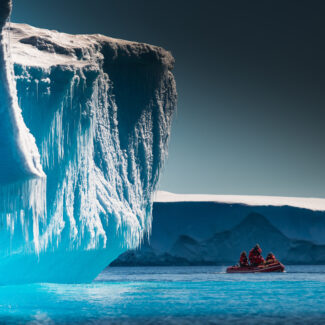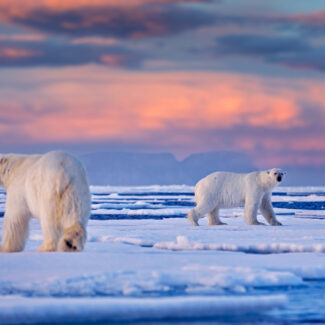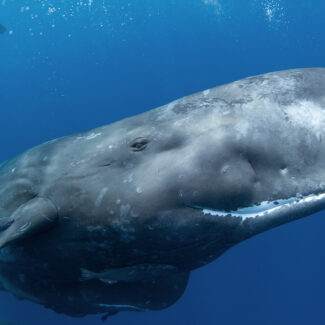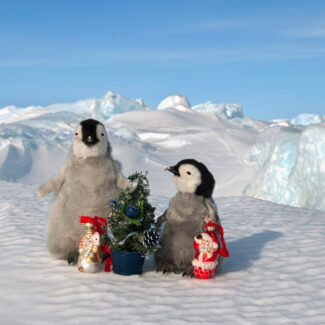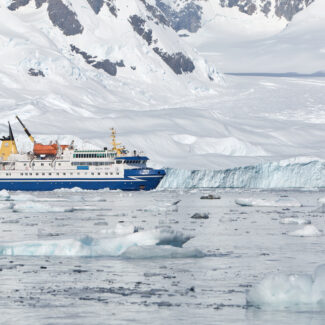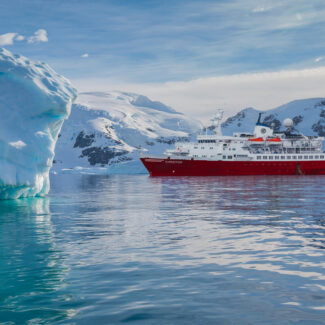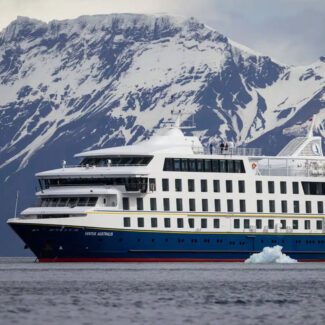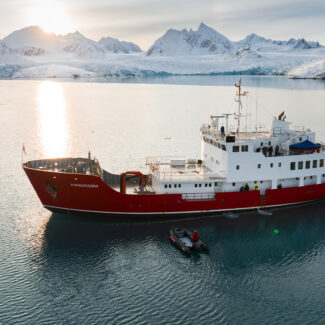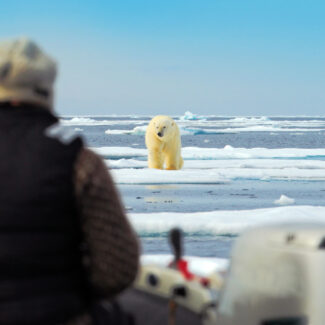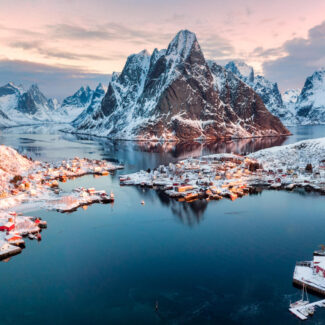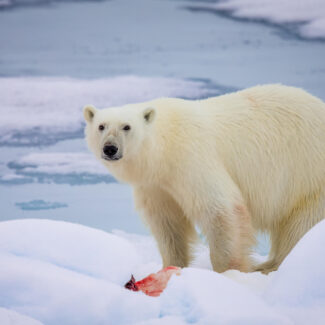Who Discovered Antarctica & When? First Sightings & Landings
For many centuries, cartographers and geographers speculated about the existence of a huge continent in the far south of the Southern Hemisphere: a Terra Australis Incognita, which was presumed to essentially balance out all of the extensive landmasses of the Northern Hemisphere. While the general notion predicted the location of Antarctica, there was no first-hand evidence it existed, and Terra Australis as popularly conceived was a mere figment of the imagination.
Why was Antarctica the last continent to be discovered? Well, given its immense remoteness, extreme conditions, and the many challenges of its encircling Southern Ocean seas—including the ferocious westerly winds and seasonal incursions of ship-busting sea ice and icebergs—it’s not necessarily surprising that the White Continent likely wasn’t seen until the early 19th century.
In this article, we’ll delve into the basics of what’s known about the discovery of Antarctica: who was the first to spot the land of Antarctica, and who probably first stepped foot on the mainland. (Meanwhile, if you’d like a more detailed history of Antarctic exploration, check out our longer article on the subject as well as our post on the famous race to the South Pole.)
When Was Antarctica Discovered?
We’ve already mentioned that Antarctica proper wasn’t definitively sighted until the early decades of the 1800s. But that’s not to say there isn’t speculation that humans may have at least penetrated Antarctic waters long before, even though the idea is hotly contested.
Did Polynesians Make the First Exploration of Antarctica?
That speculation of long-ago, pre-European exploration of Antarctica concerns those famously proficient transocean navigators, the Polynesians, who exhibited exceptional seafaring capabilities and savvy wayfinding to colonize many farflung Pacific archipelagos in Oceania. Certain interpretations of Polynesian oral traditions propose that a number of ancient navigators may have strayed into Antarctic waters. A widely cited 1899 account of the Rarotongan voyager Hui Te Rangiora suggested his canoe forayed into polar waters with bull kelp, seals, and icebergs in the seventh century CE, thereby becoming the first person to explore Antarctica.
But there’s been plenty of pushback on that account’s translation of the story’s name for those waters, Tai-Oka-a-Pia, as “Frozen Sea.” A 2021 paper in Polar Record, “A Southern Māori Perspective on Stories of Polynesian Polar Voyaging,” written by Southern Māori scholars affiliated with the University of Canterbury’s Ngāi Tahu Research Centre, suggests Tai-Oka-a-Pia more accurately means something like “Sea Covered With Foam Like Arrowroot.”
That Polar Record article notes that the Southern Māori of New Zealand would be better-positioned to voyage toward Antarctica than Cook Islanders, given the shorter distance between the South Island and the White Continent and established voyaging to some Subantarctic islands. Yet the authors point out that no ethnographic or archaeological evidence indicates Southern Māori seafaring south of the Subantarctic Auckland Islands. The possibility of traverses into Antarctic seas, they stress, would have to “be considered against formidable impediments to Antarctic voyaging in Polynesian built and rigged sailing canoes,” and a lack of evidence that even the higher-latitude Southern Māori wore robust, protective waterproof clothing.
The authors state:
Southern Māori interests have extended into the Subantarctic Islands for 800 years but there is no reference to Antarctica in our historical traditions. Our archaeology and history document a southern boundary to Māori occupation at Port Ross (Auckland Islands), despite habitable islands existing further south. We think it is very unlikely that Māori or other Polynesian voyaging reached the Antarctic.
While European exploration of Antarctica is well-documented, intriguing historical accounts and oral traditions suggest Polynesians may have ventured into the Southern Ocean long before, potentially making the first human encounters with the Antarctic region. This 1771 map, created before Antarctica was widely known to Europeans, reminds us how much of the world remained undiscovered or unrecorded by Western cartography.
Prelude to the Discovery of Antarctica
The British Royal Navy officer Captain James Cook covered a whopping amount of ground—well, mostly liquid ground—during his multiple transoceanic voyages during the 1760s and 1770s. He saw everything from the eastern shores of Australia to the Pacific coast of North America and the Hawaiian Islands. He didn’t quite make it to Antarctica, but he came remarkably close, all things considered.
This was during Cook’s second great voyage of 1772 to 1775, during which his ships Resolution and Adventure circumnavigated the Southern Hemisphere. His crew made the first landfall on the subpolar island of South Georgia (which had been first eyeballed a hundred years before by Anthony de la Roché), discovered the South Sandwich Islands, and achieved the first crossing of the Antarctic Circle (about 66 degrees S) in January 1773. Cook’s expedition ended up going south of the Antarctic Circle three times during the voyage. On February 3, 1774, Cook ventured farther south than anyone ever had, halted by pack ice at 71 degrees 10’ S.
Before the continent of Antarctica was definitively sighted, intrepid explorers like Captain James Cook charted the treacherous waters of the Southern Ocean. His voyages, meticulously documented in maps like this one, pushed the boundaries of known geography and set the stage for the eventual discovery and exploration of the mysterious white continent.
The First Person to See Antarctica
Decades would pass before the first actual sighting of Antarctica proper occurred. The year 1820 was a momentous one when it comes to the discovery of Antarctica, as at least three separate expeditions flying under different national flags came within view of the White Continent.
The man generally credited as the first person to see Antarctica is Admiral Fabian Gottlieg Thaddeus von Bellingshausen, leading a Russian expedition aboard the Vostok and Mirnyi from 1819 to 1821 that ended up circumnavigating the White Continent. On January 27, 1820, Bellingshausen observed “an ice shore of extreme height” that has been interpreted as likely the Fimbul Ice Shelf of Queen Maud Land. This expedition was also only the second to cross the Antarctic Circle, close to a half-century after Cook’s voyage achieved the feat.
Only a few days later, on January 30, 1820, a British sailor, Edward Bransfield of the Royal Navy, fresh from the first exploration of the South Shetland Islands, described witnessing the “high mountains, covered with snow” of what’s now recognized as the Trinity Peninsula, the far northern tip of the Antarctic Peninsula.
While often debated, many credit Russian naval officer Fabian Gottlieb von Bellingshausen with the first confirmed sighting of the Antarctic mainland on January 27, 1820. His meticulous logs from the Vostok and Mirny expeditions offer a compelling account of pushing through icy waters to glimpse the continent’s shores, forever changing the world map.
Who Was the First Person to Set Foot on Antarctica?
While those initial glimpses of the White Continent by Admiral Bellingshausen and Edward Bransfield are well documented, determining the first person on Antarctica is a murkier business. That’s partly because numerous sealing and whaling expeditions—mainly American and British—began penetrating Antarctic waters in the 1820s, and such explorers were not keen on publicizing their hunting grounds. It is quite likely sealers and whalers ventured ashore here and there on islands and mainland coasts without making record of it.
The first possible landfall on Antarctica that we know of, though not an entirely definitive one, involved the American sealing vessel Cecilia, captained by John Davis. The entry for February 7, 1821 in the Cecilia’s logbook notes a boat going ashore to look for seals at what may have been Hughes Bay along the Antarctic Peninsula. If that was indeed the location, this would mark the first time people had set foot on the White Continent.
But the first fully verifiable landing on the Antarctic mainland took place many decades later, on January 24, 1895, when seven crew members of the aptly named Norwegian whaling and sealing ship Antarctic went ashore via rowboat at Cape Adare in Victoria Land. Whilst all landing within seconds of each other, and some accounts suggesting the captain Leonard Kristensen or fellow Norwegian deckhand Carsten Borchgrevink—whose sketch depicting himself jumping to land first can be found above—were the first to disembark, New Zealander Alexander Francis Henry von Tunzelmann is sometimes credited as being the first person to set foot on the Antarctic mainland itself, having maintained up until his deathbed that he had held the boat steady for the rest of the group. Indeed, in 1984 the New Zealand Antarctic Place Names Committee named the landing site Von Tunzelmann Point in his honor.
It should be noted that, a few years before, in November of 1892, Captain Carl A. Larsen, leading a whaling expedition aboard the Jason, landed at Seymour Island off the northeastern coast of the Antarctic Peninsula, collecting fossils and petrified wood there. So while not technically landfall on the Antarctic continent itself, it was pretty darn close.
While the first sighting of Antarctica is debated, the first confirmed landing on the continental mainland is often attributed to Norwegian sealing captain Carsten Borchgrevink, who set foot on Cape Adare in 1895. His expedition, though not without its challenges as ships like the SS Antarctic often faced in the unforgiving ice, marked a pivotal moment in the continent’s history, paving the way for further exploration.
Who’ll Discover Antarctica Next?
Only discovered a couple of centuries ago, and still lacking a permanent human population and boasting vast tracts of barely trammeled, lightly explored land- and ice-scapes, Antarctica calls to the adventurer in all of us. A 21st-century sightseeing journey to the White Continent still feels like true, ends-of-the-Earth exploration!
Disclaimer
Our travel guides are for informational purposes only. While we aim to provide accurate and up-to-date information, Antarctica Cruises makes no representations as to the accuracy or completeness of any information in our guides or found by following any link on this site.
Antarctica Cruises cannot and will not accept responsibility for any omissions or inaccuracies, or for any consequences arising therefrom, including any losses, injuries, or damages resulting from the display or use of this information.


